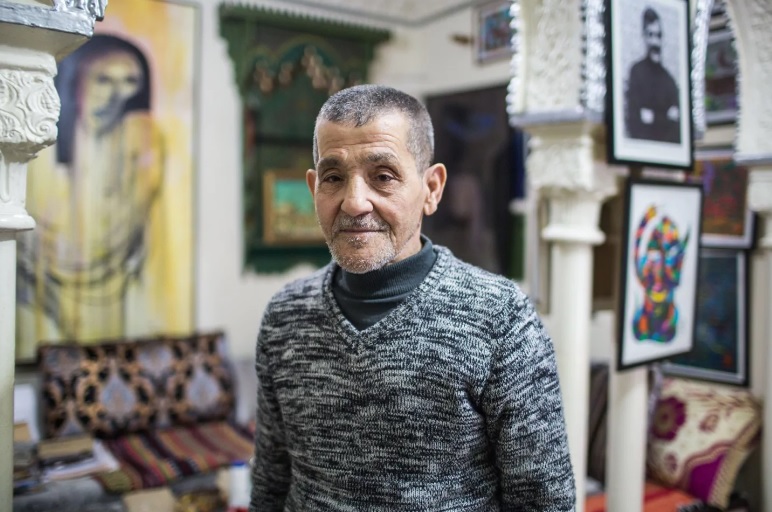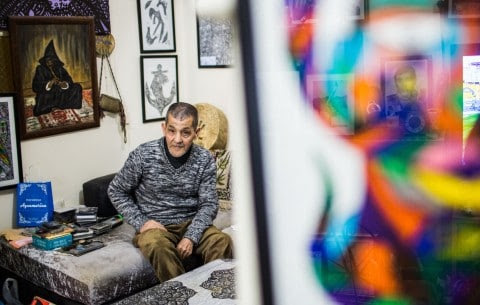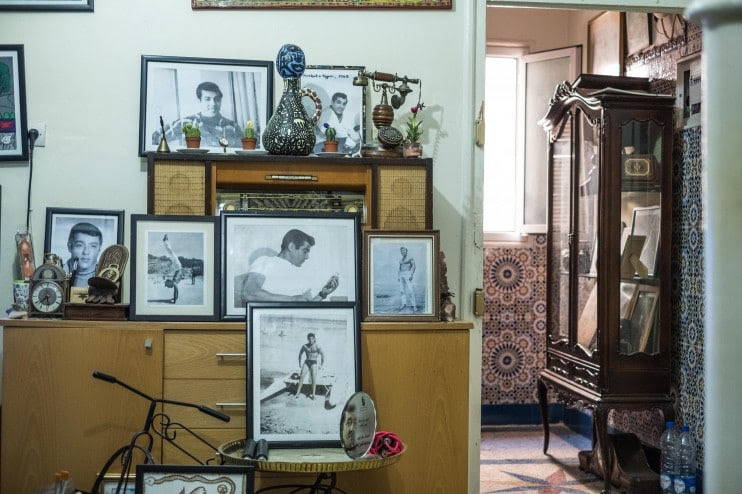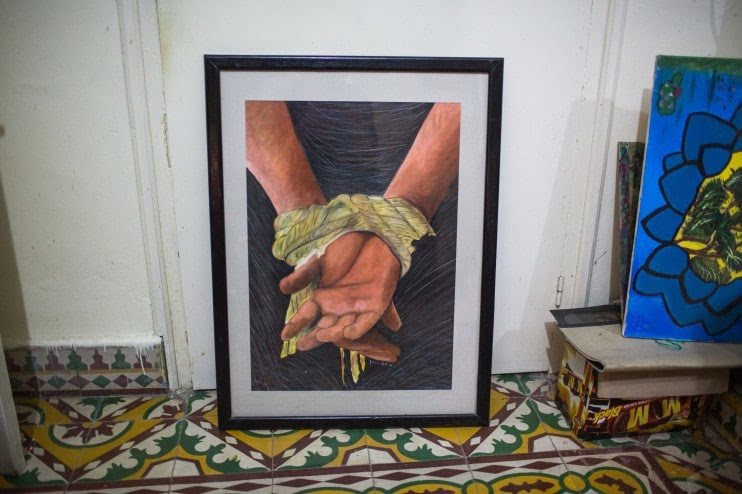The Washington Post
By Sudarsan Raghavan
Writer and artist Mohammed Mrabet, 83, at his home in Tangier, Morocco. (Yoriyas Yassine Alaoui for The Washington Post)
This may be the age of Facebook, Twitter and smartphones, but it soon became clear that these were going to be of little help. Mohammed Mrabet would be difficult to find.
His tracks, to be sure, were evident in this storied Mediterranean city of narrow alleyways and bustling French-style cafes.
At a museum on the Rue d’Amerique, a youthful Mrabet appears in photos and postcards featuring the late American expatriate writer Paul Bowles. At the Librarie des Colonnes bookstore, Mrabet’s fiction is displayed on shelves. At the Cafe du Paris, a waiter informs me that Mrabet had been there two weeks earlier.
But no one — not at the museum, the bookstore or the cafe — knew Mrabet’s telephone number or address. Social media handle? Forget it.
A writer and artist, Mrabet is the last living link to a bygone era when famed American literary figures, including many leading lights of the Beat Generation, visited this North African country for inspiration and relaxation, often facilitated by drugs. Jack Kerouac, William S. Burroughs, Allen Ginsberg, Tennessee Williams, Truman Capote — they all traveled here in the 1950s and 1960s.
Many came to see Bowles, the composer and author of “The Sheltering Sky,” who lived in Tangier for more than 50 years until his death in 1999. Mrabet, who worked closely with Bowles, knew all the Beat writers who stopped over.
Mrabet, I hoped, would transport me back to that beguiling time through his memories. But first I had to find him.
Sitting in the smoke-filled Cafe du Paris, my Moroccan translator, Amira, and I phoned the bookstore again.
On the other end, an employee gave us hope. He had identified the Tangier district of Charf-Souani as the place Mrabet may have last resided.
The narrow street of Mrabet’s Tangier neighborhood is hard to find without a guide. (Yoriyas Yassine Alaoui for The Washington Post)
So we hopped into a taxi. When we arrived, we asked around. No one had even heard of Mrabet — until one man, standing in front of his doorway, offered, “He’s the friend of that American writer, Paul Bowles, no?”
“Yes,” I said excitedly. “Do you know where he lives?”
The man shrugged. “No,” he said. “But it’s somewhere here.”
As we talked, a passerby overheard our conversation and stopped.
He was middle-aged and wearing a djellaba, a long, loosefitting, traditional robe. He said he knew a man named Mrabet. “Follow me,” he said.
It was already after dark. We had been searching since morning. We had nothing to lose.
We followed the man through a small cemetery packed with gravestones of different sizes and overgrown with weeds, through the corridors of a large, dimly lit mosque, bending and curving, until we were on a dark, narrow street.
The man stopped at a nondescript three-story townhouse. This is it, he said.
We stared at the wooden front door for a few seconds. I knocked. I knocked a little harder. A head finally popped out of the second-floor window.
It was him.
Mrabet lives among examples of his artwork, mostly colorful images that are sought by European collectors. (Yoriyas Yassine Alaoui for The Washington Post)
Mrabet came down and opened the door. At 83, he was compact and built like a gymnast. His peppery hair was cut short, almost in a crew cut. Surprisingly, he let us in at that late hour.
We ascended the narrow staircase to his studio. On the walls hung several dozen paintings and drawings, mostly colorful, surrealist and abstract images of people, animals and trees. Above a sofa was the darkest one: a painting of a black sparrow hovering behind a ghoulish figure.
In another corner were glass cases that displayed rings, bracelets and other artifacts that belonged to Bowles and his wife, Jane. Near the door were two portraits of a young Mrabet. In one, he’s bare-chested, trim and muscular, like a 1930s version of Tarzan, and in the other, he’s wearing a tight, white T-shirt, looking like a Calvin Klein model.
Mrabet, dressed in a gray sweater and tan pants, settled onto a sofa and began discussing his life — and the Beat Generation.
The door to Cafe Hafa, a favored hangout of writers in Tangier — Mrabet and Paul Bowles among them. (Yoriyas Yassine Alaoui for The Washington Post)
Born in 1936, he had grown up poor and never went to school. He had worked as a chef and a bartender before meeting Paul and Jane Bowles.
He was also a master storyteller, part of a rich Moroccan tradition.
At the time, Paul Bowles was traveling around Morocco recording the stories of Moroccan raconteurs for an oral-history project funded by a U.S. government grant.
At Jane Bowles’s recommendation, her husband asked to record Mrabet’s stories.
“Paul had a record player, and microphone,” Mrabet recalled. “I told him 30 stories.”
Afterward, Mrabet cooked dinner for the accomplished writers. They asked him to work in their house as a cook and bodyguard.
It was also the start of Mrabet’s literary and artistic career. Paul Bowles translated his short stories and later helped Mrabet get several books published, including “The Lemon” and “Love with a Few Hairs.” He also promoted Mrabet’s paintings and drawings to westerners.
The translator was his entryway to a foreign world. Mrabet traveled with him to New York City and with famed playwright Williams to Los Angeles.
In his book “Tangier,” Josh Shoemake wrote that Mrabet had “perhaps the happiest life of all of Bowles’s collaborators and lives with his children and grandchildren in Tangier, where few people still recognize his name.”
Mrabet looks at an old picture of himself from the era in which he communed with Beat Generation writers such as William S. Burroughs — and especially Paul Bowles, who translated the master storyteller’s tales. (Yoriyas Yassine Alaoui for The Washington Post)
A collection of photos and souvenirs from Mrabet’s life and travels. (Yoriyas Yassine Alaoui for The Washington Post)
Each of his paintings conveys a specific intended meaning, Mrabet says. (Yoriyas Yassine Alaoui for The Washington Post)
Indeed, Mrabet has four children, 10 grandchildren and one great grandchild. He’s content, he said, living with his wife of 54 years, Ayesha, and their family.
But he also expressed some bitterness.
Outside Morocco, he was still known and appreciated in certain literary circles. In 2016, for instance, Mrabet’s stories were the subject of a BBC broadcast, and his paintings are still sought by European collectors. Inside Morocco, however, there has been silence.
“I don’t have any value in my country,” Mrabet said. “They don’t know who I am.”
Nor does he exhibit much fondness anymore for the American writers he had befriended.
Capote, he said, was “a good man.” But, Mrabet continued, the novelist “would come and hug me and kiss me. I hated that.” Mrabet felt the same away about poet Ginsberg.
I was surprised by such homophobic sentiments. In several of Mrabet’s books, his characters are bisexual.
He also blamed the Beat writers for destroying Tangier. Their fame and writings drew “crazy people” and “drug users” to the city. “The writers brought those people with them,” Mrabet said. “They caused Tangier to die.”
And what about his mentor Paul Bowles?
They’d had a falling out. “He stole all my stories,” Mrabet said. “It’s the truth. I never received my royalties for my books from Americans. All the money went to Paul Bowles into his bank.”
“He wasn’t my friend,” he continued. “I was only working for them.”
photo
Mrabet has a melancholy moment at his home. He harbors some bitterness about his legacy in Morocco and no longer has much fondness for the American writers he befriended. (Yoriyas Yassine Alaoui for The Washington Post)
I later contacted the Wylie Agency, which represents the Estate of Paul and Jane Bowles, and received a response from Rodrigo Rey Rosa, who is in charge of Paul Bowles’s literary legacy.
Rey Rosa wrote that he was “sad” to hear Mrabet’s allegations, “which have no basis in fact.” He said there “is no truth to Mrabet’s claim not to have received royalties for the books Bowles translated.”
Bowles “had great admiration for Mrabet’s talent as an inventor of stories and he liked helping make these unique stories known to the English speaking public and the world at large. Which he did,” Rey Rosa wrote. “And I think he would have continued in this work, which he felt was important, even if he knew that one day his Moroccan friend would mistakenly accuse him of wrong-doing.”
I felt a sense of melancholy. I had been expecting a happier ending.
We finally asked Mrabet about the morbid painting of the black sparrow and the ghoul. He confirmed what I had suspected after listening to him for nearly three hours.
“That’s Jane and Paul,” Mrabet said, looking at his creation. “That’s Paul, the black sparrow. Black magic.”











